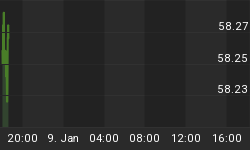Equities fell off a cliff last week and gold along with gold stocks followed. We think parachutes will open to ensure a safe landing as the financial authorities will yet again come to the rescue.
Over the last year, fuel for the equity markets has largely been coming from cheap debt available to private equity firms mostly due to the yen carry trade. The Dow Jones "Private Equity Analyst" reports that the US private equity firms raised $137 billion during the first half of 2007, a 42% increase over the first half of 2006. The cash from Leveraged Buyouts (LBOs) flooded the markets and was reinvested pushing stocks to their all-time highs. The key point here is - the stock market is being pushed up by borrowed funds. Since a lot of the debt will have to be repaid in yen, the sharp rise in the Japanese currency last week spooked all markets.
Careful market observers will note that European markets took a bigger hit than US markets last week:
- Europe 350 iShares down 7.2%
- Emerging Markets iShares down 6.4%
- S&P 500 down 5.4%

As an example, the above chart shows that the German Dax Composite underperformed the S&P 500 Index primarily due to the strength of the Japanese yen. This is the third time since last December. To us, this signifies that the yen carry trade global unwinding has now become the most serious issue among some others, such as the US subprime problems we discuss below.
Subprime Worries and Rising Credit Spreads
Additional warning signs recently emerged in the US markets that the subprime worries are starting to spill over into the private equity fundraising efforts. The latest bombshell fell when Bill Gross of Pimco commented that "enough is enough" referring to the liquidity glut that has caused artificially low interest rates for high risk debt. He warned that this debt is going to be re-priced as investors begin to realize that the subprime problem may not be an isolated event.
A crowd of highly leveraged sellers rushed for the doors causing panic selling last week. Credit spreads rose all across the board, from high quality corporate debt to junk bonds. In fact, anyone looking to sell corporate paper with less than AAA rating would have had a very difficult time. The chart below shows a ratio between the US treasury bonds and investment grade corporate bonds indicating the biggest credit spread jump in years.

Of course, Mr. Paulson, Mr. Bernanke and crew realize the risks involved. The Treasury Secretary made a few speeches last week to reassure the markets that the government remains vigilant and will prevent the problem from developing into a crisis or a panic. While many skeptics are smirking at the government's response, we think the message Mr. Paulson is sending to Mr. Gross is that "it's not yet enough" - the liquidity bubble will continue.
The government and the Fed are concerned that a further decline in the stock market could be a catalyst for an economic slowdown or even a recession. Corporate profits will dry up causing LBO related loans to turn not only to junk but to trash. As a result liquidity will plunge and yields spreads will rise further. A dry out of liquidity will in turn increase defaults among the speculative grade issuers and cause the stock market to plunge even further. A credit crunch is a nightmare scenario for any banker.
To show that it is serious about avoiding such a scenario, the Fed pumped more than $8 billion into a non-government and agency debt paper last week. Given the strength of the emerging economies and the Bank of Japan's reluctance to change its long term inflationary policy, the Fed should not have a problem this time in restoring liquidity to the market to avoid a crash scenario.
While cracks in the worldwide financial system are starting to appear, its collapse is very hard, if not impossible to time. The waiting game continues.
Implications for Precious Metals Stocks
The US stock market is extremely oversold based on a number of indicators. A rebound in the markets should happen this week, but such a recovery, we expect, will be relatively short-lived. August and September are seasonably bad months and a retest of lows set by stocks last week is highly likely.
As far as the precious metals stocks are concerned, while the correction last week may seem sharp and brutal, the technical picture remains positive. A rebound along with the rest of the market should happen shortly.
The moment of truth for the precious metals sector will occur when the next stock market decline commences. This decline will happen during a steepening yield curve environment, which is very bullish for gold. At that time, the smart money should start reallocating into the real safe haven - gold, not the US treasuries. As a result, gold and gold stocks will not follow the general market to the downside. This will mean that the new leg of the gold bull has begun.
At this critical situation we remain bullish and see this decline as another buying opportunity. To see a list of stocks we cover, go to Gold/Silver/Uranium Stock Pages.
















